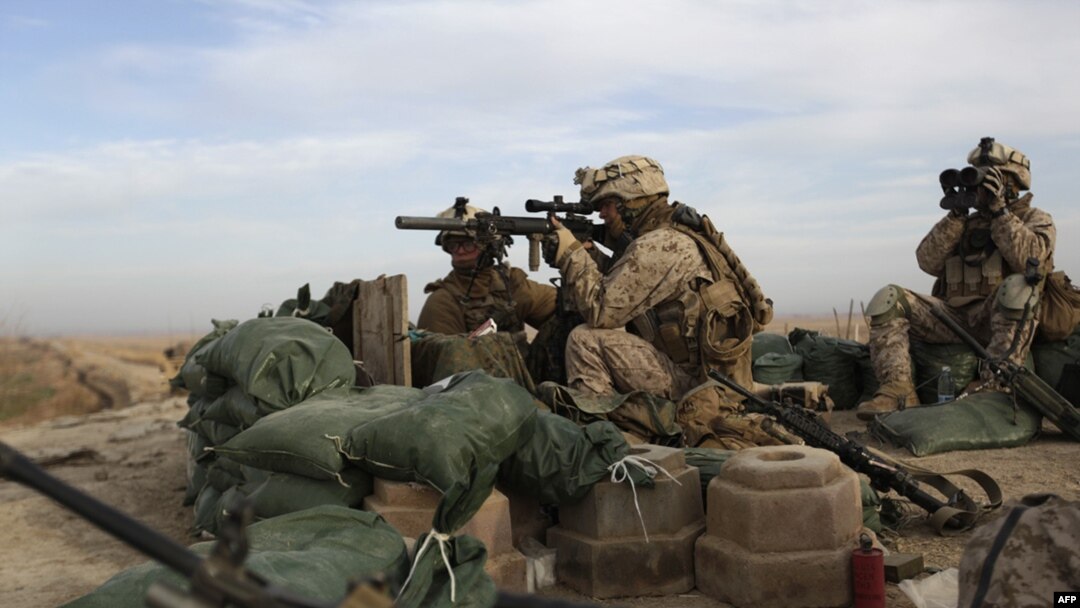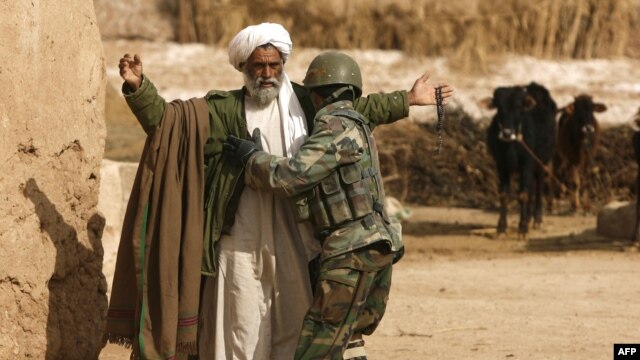(RFE/RL) -- NATO and Afghan troops today swept into Afghanistan's volatile Helmand Province in the biggest joint military offensive since the 2001 overthrow of the Taliban.
Some 15,000 U.S., British, and Afghan soldiers -- aided by 60 helicopters -- are taking part in the operation targeting the district of Marjah, one of the last big Taliban strongholds in southern Afghanistan.
Afghan officials said Operation Moshtarak -- which means "together" in the local Dari and Pashto languages -- was making good progress. They said 20 members of the Taliban were killed and 11 captured in the opening stages of the assault. A British soldier died in an explosion while on a vehicle patrol in the operation.
(Also in southern Afghanistan, five NATO troops, including three Americans, died in roadside bombings and a shooting, NATO said in a statement. It is unclear whether they were killed in the offensive.)
The NATO commander of forces in southern Afghanistan, Nick Carter, said the operation in Marjah was going "without a hitch." U.S. Lieutenant Mark Greenlief told Reuters, "We are currently moving to seize our objective. We have been in contact for five hours from the southwest, north, and east, and we are moving to push to finish securing the areas of insurgents."
In Kabul, Defense Minister Rahim Wardak told reporters most of the fighting is centered around the main market district of the town of Marjah.
It is not clear how many militants are inside Marjah, but U.S. Marine commanders have said they expect between 400 to 1,000 militants to be there, including more than 100 foreign fighters. The town is reported to have a population of some 80,000 people.
Helmand Governor Gulab Mangal told a news conference that regaining control of the province would enable Afghan authorities to bring lasting security and good governance to its population.
"The main and fundamental difference between this operation and past operations is that in this operation our forces, once they regain the region, will stay in important and strategic areas wherever they are needed," Mangal said. "Military operation is the first step of our plans. We will then launch our vast civilian programs."
Afghan President Hamid Karzai issued a statement calling on the Taliban, who have re-emerged as a powerful fighting force in recent years, to lay down their weapons and rejoin mainstream Afghan society.
Karzai also warned troops to avoid civilian casualties.
The safety of civilians is a key issue for NATO, which many Afghans accuse of killing too many civilians. Heavy civilian casualties in Marjah could further undermine efforts by the U.S.-backed Afghan government to win broader public support.
In a bid to limit civilian casualties, the alliance distributed leaflets in the Marjah area warning of the planned offensive.
Marjah resident Haji Mer Dill says forces should avoid using heavy weapons in areas still holding civilians.
"The vast forces that have entered the region must first use infantry and not heavy weaponry such as tanks and canons," he said. "But if the use of such weapons and bombardments are needed, then the people should flee."
Marjah residents today fled en masse to Lashkar Gah, the capital of Helmand Province, where police enforced tight security measures to prevent Taliban rebels from escaping.
Mohammad Naeem said he drove to Lashkar Gah after fighting erupted in his village.
"We have just arrived from Marjah. There was fighting going on in our village. The situation is very tense," he said. "We do not have any place to stay in Lashkar Gah. I have to rent a house to live, and this is very difficult for me."
The assault is the first since U.S. President Barack Obama ordered an extra 30,000 troops to Afghanistan in December.
RFE/RL's Radio Free Afghanistan contributed to this report
Some 15,000 U.S., British, and Afghan soldiers -- aided by 60 helicopters -- are taking part in the operation targeting the district of Marjah, one of the last big Taliban strongholds in southern Afghanistan.
Afghan officials said Operation Moshtarak -- which means "together" in the local Dari and Pashto languages -- was making good progress. They said 20 members of the Taliban were killed and 11 captured in the opening stages of the assault. A British soldier died in an explosion while on a vehicle patrol in the operation.
(Also in southern Afghanistan, five NATO troops, including three Americans, died in roadside bombings and a shooting, NATO said in a statement. It is unclear whether they were killed in the offensive.)
The NATO commander of forces in southern Afghanistan, Nick Carter, said the operation in Marjah was going "without a hitch." U.S. Lieutenant Mark Greenlief told Reuters, "We are currently moving to seize our objective. We have been in contact for five hours from the southwest, north, and east, and we are moving to push to finish securing the areas of insurgents."
In Kabul, Defense Minister Rahim Wardak told reporters most of the fighting is centered around the main market district of the town of Marjah.
It is not clear how many militants are inside Marjah, but U.S. Marine commanders have said they expect between 400 to 1,000 militants to be there, including more than 100 foreign fighters. The town is reported to have a population of some 80,000 people.
Helmand Governor Gulab Mangal told a news conference that regaining control of the province would enable Afghan authorities to bring lasting security and good governance to its population.
"The main and fundamental difference between this operation and past operations is that in this operation our forces, once they regain the region, will stay in important and strategic areas wherever they are needed," Mangal said. "Military operation is the first step of our plans. We will then launch our vast civilian programs."
Afghan President Hamid Karzai issued a statement calling on the Taliban, who have re-emerged as a powerful fighting force in recent years, to lay down their weapons and rejoin mainstream Afghan society.
Karzai also warned troops to avoid civilian casualties.
The safety of civilians is a key issue for NATO, which many Afghans accuse of killing too many civilians. Heavy civilian casualties in Marjah could further undermine efforts by the U.S.-backed Afghan government to win broader public support.
In a bid to limit civilian casualties, the alliance distributed leaflets in the Marjah area warning of the planned offensive.
Marjah resident Haji Mer Dill says forces should avoid using heavy weapons in areas still holding civilians.
"The vast forces that have entered the region must first use infantry and not heavy weaponry such as tanks and canons," he said. "But if the use of such weapons and bombardments are needed, then the people should flee."
Marjah residents today fled en masse to Lashkar Gah, the capital of Helmand Province, where police enforced tight security measures to prevent Taliban rebels from escaping.
Mohammad Naeem said he drove to Lashkar Gah after fighting erupted in his village.
"We have just arrived from Marjah. There was fighting going on in our village. The situation is very tense," he said. "We do not have any place to stay in Lashkar Gah. I have to rent a house to live, and this is very difficult for me."
The assault is the first since U.S. President Barack Obama ordered an extra 30,000 troops to Afghanistan in December.
RFE/RL's Radio Free Afghanistan contributed to this report



